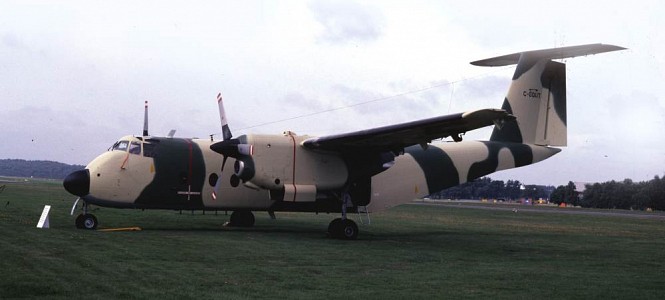Aircraft / Transport aircraft / De Havilland Canada DHC-5 Buffalo
De Havilland Canada DHC-5 Buffalo
General Facts
- TYPE
Transport aircraft - ORIGIN
 Canada
Canada - NICKNAMES
CC-115 (Canadian service)
AC-2 / CV-7A / C-8A (US service) - DESIGNED
Early 1960's - DESIGNER
De Havilland Canada - PRODUCTION
1964 - 1972 (DHC-5A)
1974 - 1986 (DHC-5D) - PRODUCERS
 Canada - De Havilland Canada
Canada - De Havilland Canada - QUANTITY
123 - UNIT COST
Unknown - CHARACTERISTICS
 Phenomenal STOL capability
Phenomenal STOL capability
 Rugged and reliable
Rugged and reliable
 Good cargo capacity
Good cargo capacity
 Limited speed
Limited speed
 Limited range at maximum payload
Limited range at maximum payload
Introduction
The DHC-5 Buffalo is a transport aircraft of Canadian origin. It was developed in the early 1960's as a follow on to the widely sold DHC-4 Caribou. It was designed to US specifications, but the US requirement was dropped when development was complete. The DHC-5 was produced for military use, although a small number ended up in civilian use.
Layout
The DHC-5 is a larger version of the DHC-4 Caribou. Whereas the DHC-4 had piston engines the DHC-5 uses turboprops. The layout remains the same with a single high lift shoulder mounted wing, two propeller engines, a double wheel tricycle landing gear and rear loading ramp.
Cargo
The DHC-5 has a maximum payload capacity of 6.3 t and the cabin has been designed to carry a single Pershing missile, a M151 truck, a 105mm howitzer or 41 combat troops.
Mobility
The DHC-5 has a phenomenal STOL capability and requires as little as 300 meters of runway for take-off. The maximum speed at altitude is 435 km/h and the economic speed is 335 km/h. With limited cargo the range its range of 3.500 km is good, but at maximum payload this is reduced to only 815 km.
Users
The anticipated major US order never materialized but the DHC-5 was quite successful nonetheless. Over 15 nations acquired the DHC-5 and many remain in service today. Most users are located in Africa and North and South America.
DHC-5 Buffalo
DHC-5: Original version developed for the US Army.
DHC-5A: Slightly altered DHC-5 for Canadian use and export.
DHC-5D: New production run with more powerful engines and increased performance.
| Type | Transport aircraft |
|---|---|
| Crew | 3 + 41 (pilot, copilot, crew chief, 41 passengers) |
| Length | 24.08 m |
| Width | 29.26 m wingspan, 9.75 m tailplane |
| Height | 8.73 m |
| Surface | 87.8 m2 |
| Weight | 10.5 t empty, 18.6 t MTOW |
| Powerplant | 2x General Electric CT64-820-1 turboprop, 3.055 hp each |
| Speed | 435 km/h maximum at 3 km, 335 km/h economic at 3 km |
| Range | 3.500 km with max fuel and 1.8 t payload, 815 km with max payload |
| Fuel | 7.900 L |
|---|---|
| Climb rate | 9.6 m/s at sea level |
| Ceiling | ? |
| Landing gear | Retractable tricycle, all double wheels, 9.29m track, 8.50 m wheelbase |
| Cargo | 6.3 t maximum, 41 passengers, 24 stretchers |
| Systems | - |
| Remarks | 317 m take-off run |
| Weapon systems | - |
| Fixed weapons | - |
| Hardpoints | - |
| Option 1 | - |
|---|---|
| Option 2 | - |
| Option 3 | - |
| Option 4 | - |
| Option 5 | - |
| Option 6 | - |
| Option 7 | - |
| Option 8 | - |
| Type | Transport aircraft |
|---|---|
| Crew | 3 + 41 (pilot, copilot, crew chief, 41 passengers) |
| Length | 24.08 m |
| Width | 29.26 m wingspan, 9.75 m tailplane |
| Height | 8.73 m |
| Surface | 87.8 m2 |
| Weight | 11.4 t empty, 22.3 t MTOW |
| Powerplant | 2x General Electric CT64-820-4 turboprop, 3.133 hp each |
| Speed | 467 km/h maximum at 3 km, 124 km/h stall speed |
| Range | 1.112 km at 3 km and max payload |
| Fuel | 7.900 L |
|---|---|
| Climb rate | 11.8 m/s |
| Ceiling | 9.5 km |
| Landing gear | Retractable tricycle, all double wheels, 9.29m track, 8.50 m wheelbase |
| Cargo | 6 to 7 t maximum, 41 passengers, 24 stretchers |
| Systems | - |
| Remarks | 300 m take-off run |
| Weapon systems | - |
| Fixed weapons | - |
| Hardpoints | - |
| Option 1 | - |
|---|---|
| Option 2 | - |
| Option 3 | - |
| Option 4 | - |
| Option 5 | - |
| Option 6 | - |
| Option 7 | - |
| Option 8 | - |



